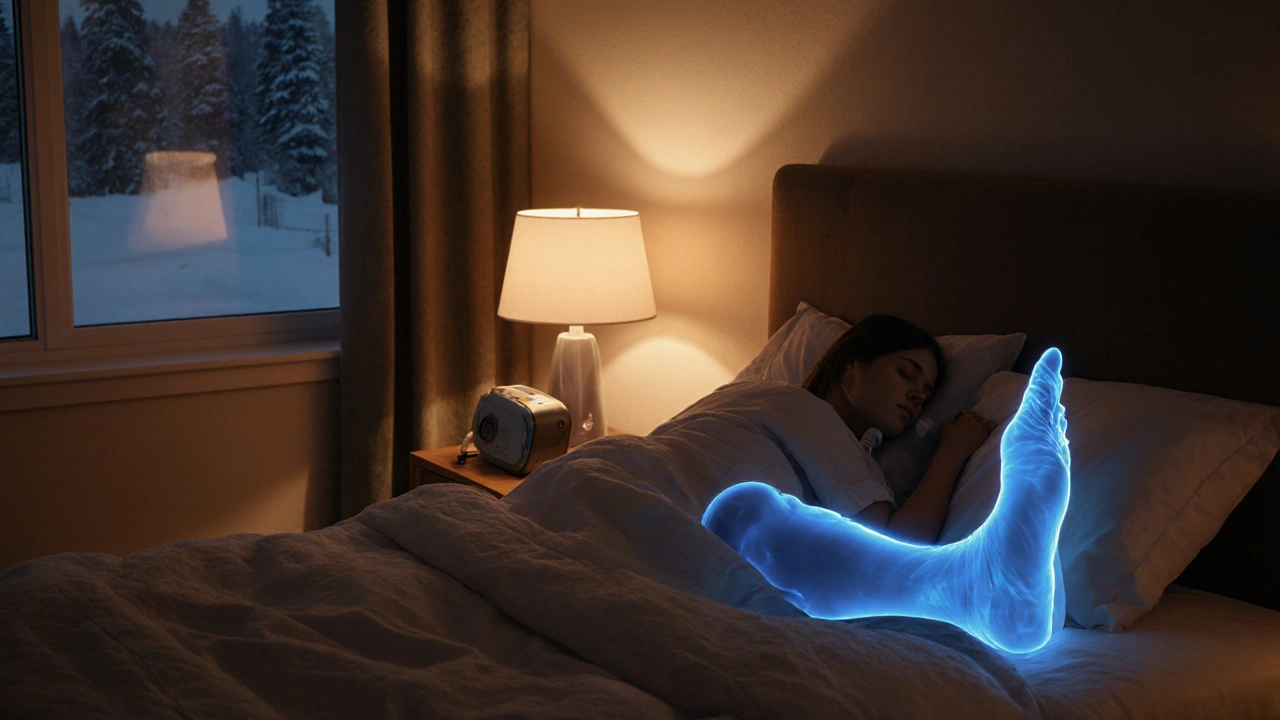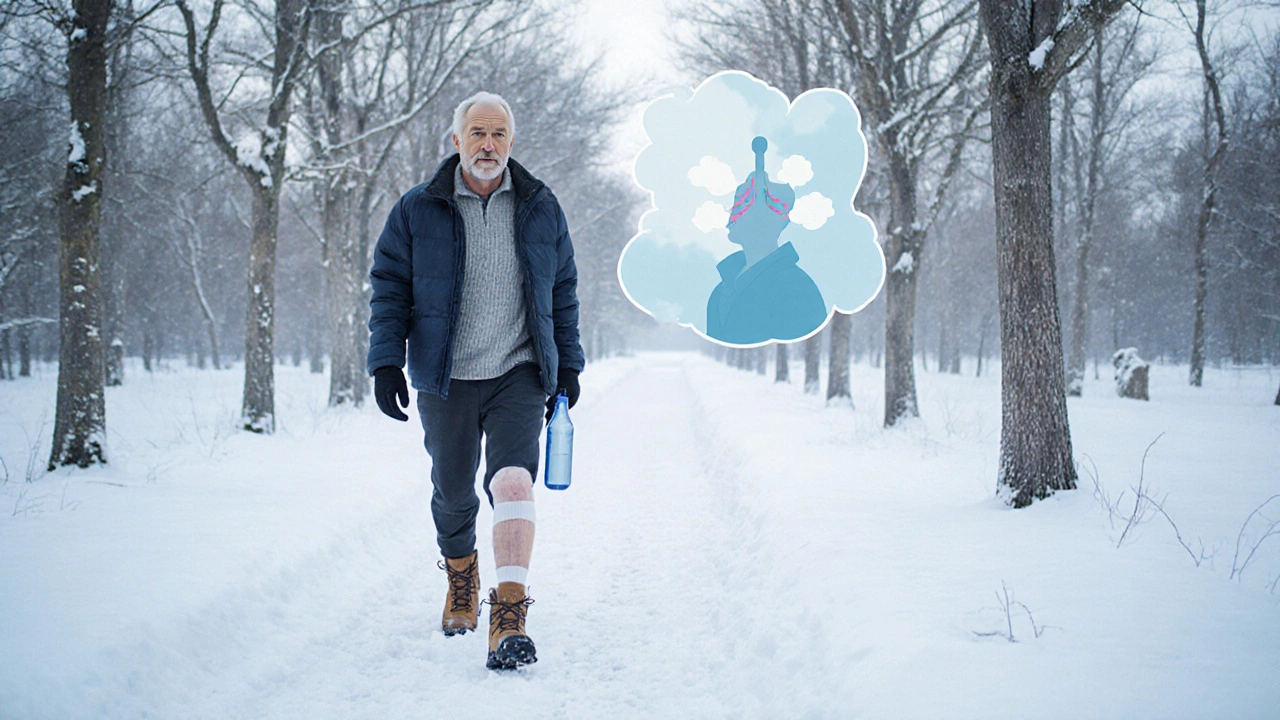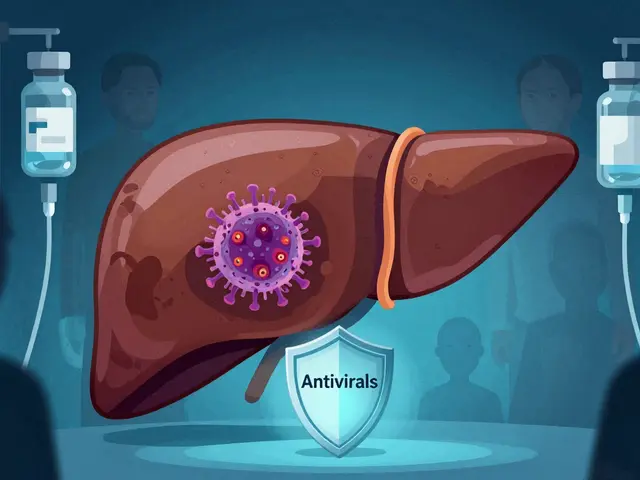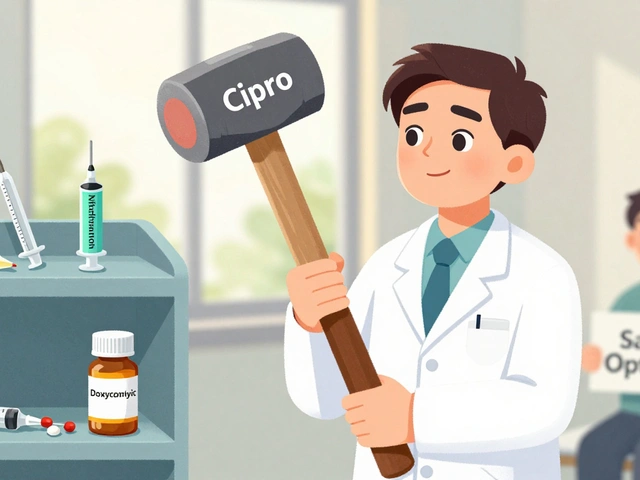
Ever wake up with puffier eyes, tight shoes, or a sore neck and wonder if it’s just a bad night’s sleep? The truth is that Oedema and Sleep Apnea often travel together, each feeding the other in a vicious cycle. Understanding that connection can help you break it, whether you’re dealing with occasional snoring or chronic fluid retention.
What Is Oedema?
Oedema is a condition characterized by excess fluid accumulation in the body’s interstitial spaces, typically showing up as swelling in the legs, ankles, hands, or face. Common causes include heart failure, kidney disease, high sodium intake, and prolonged sitting. Key attributes are:
- Location: peripheral (legs, feet) or facial (around eyes)
- Onset: can be acute (hours) or chronic (weeks/months)
- Associated symptoms: weight gain, tight clothing, shortness of breath
What Is Sleep Apnea?
Sleep Apnea is a sleep‑related breathing disorder where the airway collapses or the brain fails to send proper breathing signals. The result: repeated pauses in breathing that can last from a few seconds to minutes, disrupting sleep architecture.
- Types: Obstructive Sleep Apnea (OSA) - physical blockage; Central Sleep Apnea - neurological signal loss
- Prevalence: affects roughly 1 in 5 adults, with higher rates in men and older individuals
- Symptoms: loud snoring, morning headaches, daytime fatigue, and nocturnal choking
How Fluid Retention Impacts the Airway
The link isn’t magic; it’s physics and biology. When fluid builds up in the lower extremities, gravity can shift some of that excess toward the neck and face while you lie down. That extra fluid swells the soft tissue around the tongue and pharynx, narrowing the airway just enough for OSA to flare up. In turn, apneic events cause spikes in blood pressure, which push more fluid out of the vascular system into surrounding tissues, worsening oedema. This feedback loop explains why patients with congestive heart failure often report both swollen ankles and louder snoring.
Key Physiological Bridges
Three major systems connect oedema and sleep apnea:
- Renin‑Angiotensin‑Aldosterone System (RAAS): sleep‑related hypoxia triggers RAAS activation, leading to sodium retention and fluid overload.
- Hypertension: frequent apneas raise systolic pressure, which forces fluid out of capillaries into interstitial spaces, aggravating swelling.
- Obesity: excess adipose tissue stores sodium, raises inflammatory markers, and adds mechanical load around the neck, making both oedema and airway collapse more likely.
Understanding these bridges helps clinicians target treatment beyond a single symptom.
Diagnosing the Dual Problem
When a patient presents with swollen ankles and reports loud snoring, a two‑pronged diagnostic approach is essential.
- Polysomnography is a overnight sleep study that records breathing patterns, oxygen levels, and brain activity, providing the gold‑standard apnea‑hypopnea index (AHI). It also captures body position, helping to see if supine sleep worsens both swelling and breathing pauses.
- Physical exam: check for pitting oedema, measure neck circumference, and assess blood pressure trends.
- Laboratory tests: BNP for heart strain, serum creatinine for kidney function, and electrolytes to gauge fluid balance.
Treatment Overlap: When One Fixes Both
Because the conditions reinforce each other, many interventions hit two birds with one stone.
- CPAP therapy (Continuous Positive Airway Pressure) delivers steady air pressure to keep the airway open. By normalizing oxygen levels, CPAP reduces RAAS spikes, which can lower nighttime fluid shifts.
- Diuretics: Low‑dose loop diuretics lessen overall fluid volume, decreasing neck tissue swelling and easing apnea severity.
- Weight loss: Losing 5‑10% of body weight can shrink neck circumference by up to 1cm and reduce systemic inflammation, directly improving both oedema and AHI.
- Positional therapy: Sleeping with the head elevated (30‑45 degrees) uses gravity to keep fluid from pooling in the upper airway.
It’s crucial to coordinate care-your sleep specialist, cardiologist, and primary physician should share data to avoid over‑diuresis or CPAP pressure mis‑settings.

When to Seek Help
If you notice any of these red flags, it’s time to act:
- Rapidly increasing swelling in the legs or face within days
- Loud, choking snoring that wakes you or your partner
- Morning headaches that improve after coffee but return by afternoon
- Daytime fatigue that interferes with work or safety (e.g., driving)
- High blood pressure readings that stay above 140/90mmHg despite medication
Early intervention can prevent progression to heart failure or severe OSA, both of which carry long‑term health risks.
Related Concepts
These topics often appear alongside oedema‑sleep apnea discussions and are worth exploring next:
- Venous insufficiency - how poor leg vein function contributes to fluid back‑up
- Kidney function - the role of glomerular filtration rate in fluid balance
- Atrial fibrillation - a common arrhythmia linked to both OSA and fluid overload
- Pulmonary hypertension - high pressure in lung arteries that can worsen nocturnal breathing
- Nighttime polyuria - frequent urination that many OSA patients experience, indicating fluid redistribution
Comparison of Obstructive vs. Central Sleep Apnea
| Feature | Obstructive Sleep Apnea (OSA) | Central Sleep Apnea (CSA) |
|---|---|---|
| Primary cause | Physical blockage of upper airway | Brain fails to send breathing signal |
| Typical AHI range | 15‑30events/hr (moderate) to >30 (severe) | 5‑20events/hr (often milder) |
| Response to CPAP | Usually effective | May need adaptive servo‑ventilation |
| Associated fluid shift | Neck tissue edema common | Less directly linked to peripheral edema |
| Common comorbidities | Obesity, hypertension, heart failure | Stroke, opioid use, chronic kidney disease |
Practical Checklist for Managing Both Conditions
- Track nightly symptoms (snoring intensity, awakenings) in a sleep diary.
- Measure leg circumference each morning; note any increase.
- Keep blood pressure logs; aim for < 130/80mmHg if possible.
- Discuss CPAP pressure adjustments with your sleep tech if you notice worsening swelling.
- Limit sodium to < 2,300mg per day; increase potassium‑rich foods.
- Schedule quarterly follow‑ups that include both sleep study review and edema assessment.
Bottom Line
Fluid retention and airway collapse are two sides of the same coin for many patients. By treating the underlying fluid balance-through diet, diuretics, and weight loss-you can lighten the load on the airway, making CPAP more comfortable and reducing apnea severity. Conversely, effective CPAP therapy can dampen the hormonal cascades that drive oedema. The synergy means you don’t have to choose between breathing easy at night and looking and feeling less puffy by day.
Frequently Asked Questions
Can Oedema cause sleep apnea, or is it the other way around?
Both directions are possible. Fluid that shifts to the neck while you lie down can narrow the airway and trigger obstructive events. Those apneas, in turn, cause spikes in blood pressure and hormonal changes that promote fluid retention. So it’s a two‑way street, and breaking the loop often requires treating both sides.
Will using a CPAP machine reduce my swelling?
Yes, for many people. CPAP stabilizes oxygen levels, which lowers the activation of the renin‑angiotensin‑aldosterone system that drives sodium and water retention. You may notice less puffiness around the eyes and a tighter fit of shoes after a few weeks of consistent use.
Are diuretics safe to combine with CPAP therapy?
Generally, yes, but dosage matters. A low dose of a loop diuretic can reduce overall fluid volume without causing dehydration or electrolyte imbalance. Always coordinate with your cardiologist or primary care doctor to fine‑tune the regimen.
How much weight loss is needed to improve both conditions?
Research shows that a 5‑10% reduction in body weight can shrink neck circumference by about 0.5‑1cm and lower the apnea‑hypopnea index by 20‑30%. The same weight loss also cuts sodium retention and improves heart function, easing oedema.
Is there a simple home test to spot the link between swelling and sleep apnea?
Try a “morning‑evening” fluid check. Measure your ankle or calf circumference before bed and again after waking. An increase of more than 1cm often signals fluid shifting overnight, which correlates with worsened OSA in many studies. Pair this with a basic sleep diary to note snoring intensity.






16 Comments
Hey folks, you ever notice how the big pharma giants love to push diuretics while conveniently ignoring the root cause? It's like they're feeding the fluid monster just to keep the prescription pipeline full. The fluid shift into the neck that triggers apnea is probably engineered to keep us hooked on CPAP machines, which are another revenue stream. Anyway, keep an eye on your sodium intake and maybe question who's really profiting from your puffiness.
Interesting read, the article nicely ties the RAAS activation to nighttime fluid redistribution. The physiological explanation about gravity pulling fluid toward the head while supine is spot on. Also, the checklist at the end gives practical steps for patients. I appreciate the balanced tone between cardiology and sleep medicine.
Great summary! Remember, tracking your ankle circumference each morning can be a game‑changer. If you see a jump of more than a centimeter, that fluid shift is probably worsening your apnea. Pair that with a sleep diary and you’ll have solid data for your doctor. Keep it up, you’re on the right track!
The way fluid accumulation can tighten the airway is fascinating. It makes me think about how even a small weight loss can shrink neck tissue and break the cycle. Combining a modest diet change with a CPAP trial could give noticeable results quickly. Definitely worth trying.
Wow!! This is super helpful!!! 💤💧 Remember to keep your sodium < 2,300 mg and elevate your head while sleeping! 🌙📈 You’ll notice less puffiness around the eyes and a quieter night! Keep pushing, you’ve got this!!! 😎👍
When we look at the interplay between oedema and sleep apnea, we are really observing a classic feedback loop that involves multiple organ systems. First, fluid accumulation in the lower extremities increases venous pressure, which predisposes fluid to migrate when a person lies down. Gravity then assists in moving that excess fluid toward the head and neck, causing subtle swelling of the pharyngeal tissues. This swelling narrows the upper airway, making it more prone to collapse during the negative pressure swings of inspiration. Each apnea event, in turn, triggers a sympathetic surge that spikes blood pressure and activates the renin‑angiotensin‑aldosterone system. The RAAS response promotes sodium and water retention, adding more volume to the extracellular compartment. As the total fluid volume rises, the cycle repeats with even greater magnitude. Over time, the chronic intermittent hypoxia associated with untreated apnea can lead to endothelial dysfunction, further compromising vascular compliance. The compromised vessels become less able to accommodate fluid shifts, which exacerbates peripheral oedema. Moreover, the repeated arousals from apnea fragment sleep architecture, reducing the restorative phases of deep sleep. This sleep fragmentation impairs hormonal regulation of appetite and metabolism, often leading to weight gain. The added adipose tissue around the neck contributes additional mechanical load, tightening the airway even further. Thus, lifestyle interventions such as modest weight loss can have a cascading benefit across the entire system. Simultaneously, effective CPAP therapy reduces the frequency of apneic events, dampening the sympathetic and RAAS spikes. When both strategies are employed together, patients often experience a noticeable reduction in both swelling and daytime fatigue, illustrating the power of a dual‑approach treatment plan.
Diuretics can cut down the fluid load, which often eases the airway pressure needed for CPAP.
These articles are just hype for the medical industry.
People don't realize how the sleep study data can be cherry‑picked to push expensive equipment. The loop of fluid retention feeding apnea and vice versa is a perfect excuse for endless follow‑up appointments. It's like the system wants us dependent on gadgets forever.
While the mechanisms are sound, it would be beneficial to see more community‑based research on low‑cost interventions. Simple posture changes and moderate salt reduction could be emphasized more.
It is commendable that the article elucidates the physiological connections, yet it neglects to address how the National Health Service can streamline integrated care pathways. A coordinated effort between cardiology and sleep services within the United Kingdom would markedly improve patient outcomes.
Actually, the link between nocturnal fluid shift and obstructive events has been well documented since the early 2000s, and the role of nocturnal polyuria is often underappreciated. Moreover, newer studies suggest that distal limb compression garments can mitigate the fluid migration, a fact many clinicians overlook.
Honestly the whole thing feels like a marketing ploy for the medical industry and the endless cycle of swelling and snoring just keeps patients hooked on costly treatments and endless prescriptions the article glosses over the fact that simple lifestyle changes like reducing sodium and sleeping with the head elevated are often dismissed in favor of pricey CPAP machines and fancy diuretics which only benefit the pharma giants we all know are pulling the strings behind the scenes we could honestly break the cycle ourselves if we just paid attention to our bodies and stopped trusting every new gadget that gets advertised everywhere the truth is far simpler than they make it seem and the average person is left confused and over‑medicated
From a systems‑biology perspective, the inter‑organ crosstalk mediated by RAAS and sympathetic overdrive constitutes a positive feedback loop that can be modelled using differential equations. Implementing a multimodal intervention-combining CPAP titration, diuretic optimization, and targeted nutraceuticals-can attenuate the eigenvalues of the system, stabilizing homeostasis.
One must confess that the labyrinthine interplay of hydrostatic pressures, endocrine cascades, and aerodynamically compromised conduits evokes a veritable tapestry of pathophysiological intrigue, a narrative that the mainstream media dare not fully unravel. It is, undoubtedly, the grand theatre of modern medicine where the puppeteers-be they corporate overlords or entrenched academic dogmas-pull strings behind the veil of empirical data, coaxing the unsuspecting populace into a perpetual dance of dependence.
Interesting read 😊 but I think they ignore the cultural dietary habits that could be the real culprit 😏.